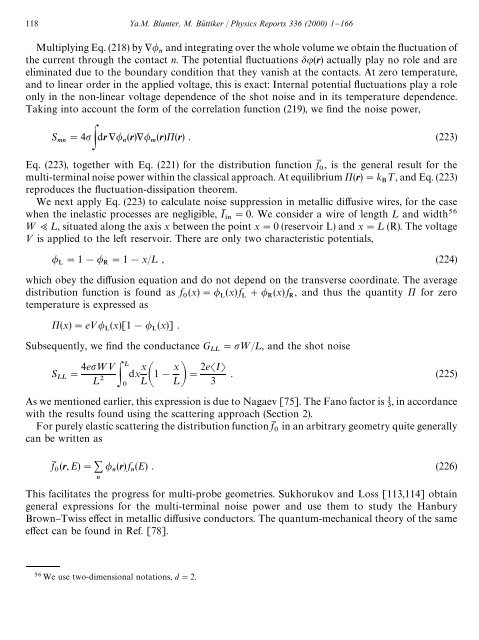shot noise in mesoscopic conductors - Low Temperature Laboratory
shot noise in mesoscopic conductors - Low Temperature Laboratory
shot noise in mesoscopic conductors - Low Temperature Laboratory
You also want an ePaper? Increase the reach of your titles
YUMPU automatically turns print PDFs into web optimized ePapers that Google loves.
118 Ya.M. Blanter, M. Bu( ttiker / Physics Reports 336 (2000) 1}166<br />
Multiply<strong>in</strong>g Eq. (218) by and <strong>in</strong>tegrat<strong>in</strong>g over the whole volume we obta<strong>in</strong> the #uctuation of<br />
the current through the contact n. The potential #uctuations (r) actually play no role and are<br />
elim<strong>in</strong>ated due to the boundary condition that they vanish at the contacts. At zero temperature,<br />
and to l<strong>in</strong>ear order <strong>in</strong> the applied voltage, this is exact: Internal potential #uctuations play a role<br />
only <strong>in</strong> the non-l<strong>in</strong>ear voltage dependence of the <strong>shot</strong> <strong>noise</strong> and <strong>in</strong> its temperature dependence.<br />
Tak<strong>in</strong>g <strong>in</strong>to account the form of the correlation function (219), we "nd the <strong>noise</strong> power,<br />
S "4 dr (r) (r)(r) . (223)<br />
Eq. (223), together with Eq. (221) for the distribution function fM , is the general result for the<br />
multi-term<strong>in</strong>al <strong>noise</strong> power with<strong>in</strong> the classical approach. At equilibrium (r)"k ¹, and Eq. (223)<br />
reproduces the #uctuation-dissipation theorem.<br />
We next apply Eq. (223) to calculate <strong>noise</strong> suppression <strong>in</strong> metallic di!usive wires, for the case<br />
when the <strong>in</strong>elastic processes are negligible, IM "0. We consider a wire of length ¸ and width<br />
=;¸, situated along the axis x between the po<strong>in</strong>t x"0 (reservoir L) and x"¸ (R). The voltage<br />
< is applied to the left reservoir. There are only two characteristic potentials,<br />
"1! "1!x/¸ , (224)<br />
which obey the di!usion equation and do not depend on the transverse coord<strong>in</strong>ate. The average<br />
distribution function is found as f (x)" (x) f # (x) f , and thus the quantity for zero<br />
temperature is expressed as<br />
(x)"e< (x)[1! (x)] .<br />
Subsequently, we "nd the conductance G "=/¸, and the <strong>shot</strong> <strong>noise</strong><br />
<br />
S "<br />
4e=<<br />
¸ <br />
dx<br />
<br />
x<br />
¸1!x ¸ "2eI . (225)<br />
3<br />
As we mentioned earlier, this expression is due to Nagaev [75]. The Fano factor is , <strong>in</strong> accordance<br />
<br />
with the results found us<strong>in</strong>g the scatter<strong>in</strong>g approach (Section 2).<br />
For purely elastic scatter<strong>in</strong>g the distribution function fM <strong>in</strong> an arbitrary geometry quite generally<br />
<br />
can be written as<br />
fM (r, E)" (r) f (E) . (226)<br />
<br />
<br />
This facilitates the progress for multi-probe geometries. Sukhorukov and Loss [113,114] obta<strong>in</strong><br />
general expressions for the multi-term<strong>in</strong>al <strong>noise</strong> power and use them to study the Hanbury<br />
Brown}Twiss e!ect <strong>in</strong> metallic di!usive <strong>conductors</strong>. The quantum-mechanical theory of the same<br />
e!ect can be found <strong>in</strong> Ref. [78].<br />
We use two-dimensional notations, d"2.
















